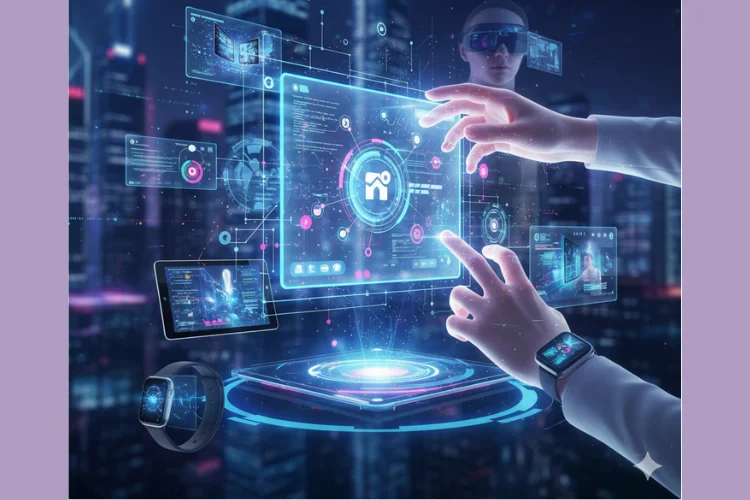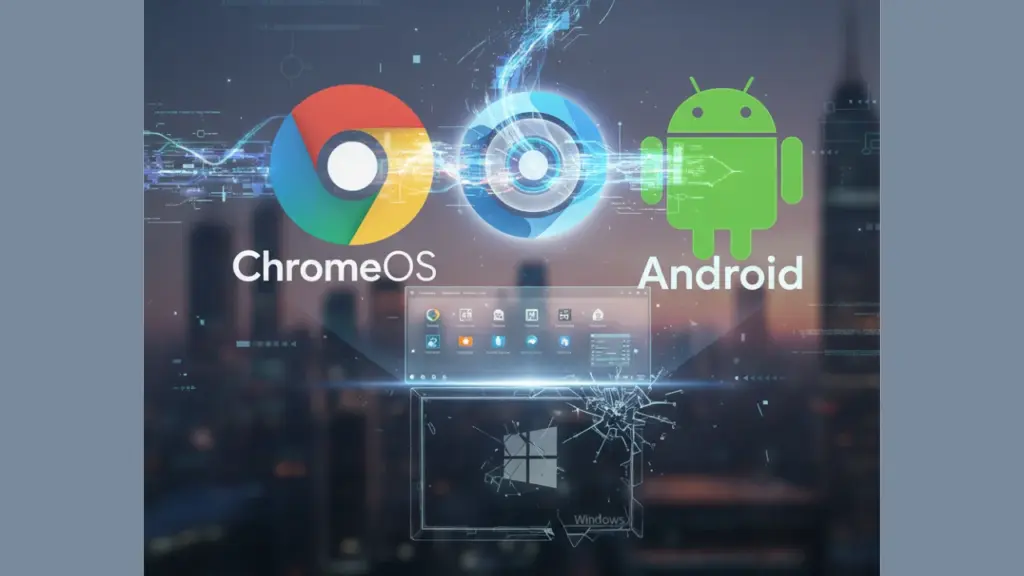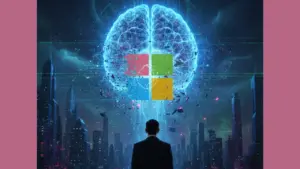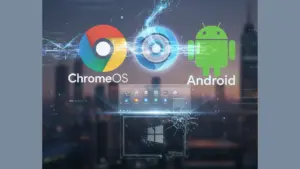1. Introduction: The Future of Computing Is About to Change
The tech world is buzzing again—this time, it’s Google making waves.
In partnership with Qualcomm, Google is merging ChromeOS and Android into a single PC platform.
This isn’t just another software update; it’s a strategic leap that could reshape the entire PC industry. For years, Windows and macOS have dominated personal computing. But with this move, Google is positioning itself as a serious contender in the desktop space.
During the announcement, Qualcomm’s CEO couldn’t hide his excitement, hinting that what’s coming could reignite app development and transform the developer ecosystem. The future of computing, it seems, is about to get much more interesting.
2. The Vision Behind the Merger
To understand Google’s decision, we need to look at the bigger picture.
Android has become the world’s most used mobile operating system, powering billions of smartphones. ChromeOS, on the other hand, has gained traction in schools, enterprises, and budget-friendly laptops.
By merging ChromeOS and Android, Google aims to unify the user experience across devices—from phones and tablets to laptops and desktops. Imagine being able to install your favorite Android apps directly on your PC, without emulators or compatibility issues.
The company’s long-term goal is clear: to create a single, seamless ecosystem that supports all types of devices and users. Qualcomm’s advanced Snapdragon processors will help make this possible, delivering improved performance, longer battery life, and enhanced AI capabilities.
This unified platform could bring the simplicity of Android and the productivity of ChromeOS into one powerful system—optimized for both touch and keyboard users.
3. A Direct Challenge to Windows
Let’s be honest—Google is taking direct aim at Microsoft’s throne.
For decades, Windows has been the undisputed leader in the PC market. Microsoft tried to merge the mobile and desktop experience with Windows Phone and Surface Duo, but those efforts never truly connected with users.
Google’s approach, however, might succeed where Microsoft stumbled.
Why? Because Google already has a massive developer base that builds for Android. Integrating that ecosystem into PCs gives developers an instant opportunity to scale their apps to millions of new users without reinventing the wheel.
Additionally, Google’s emphasis on cloud services, AI integration, and app ecosystem makes its strategy more adaptable to modern computing trends.
If executed correctly, this could change how we define personal computers in the next decade.
4. What This Means for Developers
For developers, this is perhaps the most exciting part.
The unification of Android and ChromeOS means a single codebase can now target more devices. App developers can design once and deploy everywhere—phones, tablets, and PCs.
This streamlined approach reduces development costs and increases market reach. It’s a massive opportunity for app creators looking to expand into desktop computing without rewriting their software.
The introduction of Android-powered PCs could also reignite interest in native app development.
Web apps will continue to play a role, but native apps will deliver smoother performance, better integration, and offline capabilities.
Even fractional CTOs—those providing strategic technology leadership to startups—will find this merger worth watching. It offers new possibilities for companies looking to develop cross-platform products efficiently. By adopting this new ecosystem early, startups can reduce technical debt and speed up time to market.
5. The Business Impact
This merger isn’t just a win for developers—it’s a game-changer for businesses too.
For companies that rely on Google’s productivity suite, this unified OS could streamline workflows across mobile and desktop environments. Employees will be able to access the same tools, data, and apps no matter which device they’re using.
Education is another sector that could benefit greatly.
Chromebooks already dominate classrooms in many countries. Imagine those same devices now running powerful Android apps for creative design, coding, or even gaming. This move could make hybrid learning more interactive and affordable.
Enterprises, too, will gain more flexibility.
With improved app compatibility and hardware efficiency from Qualcomm, companies can deploy cost-effective PC solutions without sacrificing performance or security.
This shift could also open new markets for device manufacturers, encouraging innovation in PC design and performance. The result? A fresh wave of lightweight, high-performance Android-based laptops ready to compete with Windows devices.
6. Qualcomm’s Role: Powering the Future
None of this would be possible without Qualcomm.
The company’s cutting-edge Snapdragon chips are already known for powering the best Android phones. Now, those same chips are being optimized for desktop computing.
During the announcement, Qualcomm’s CEO shared his enthusiasm, saying he’s “seen it, and it’s incredible.” That confidence comes from more than hype—Qualcomm’s new processors will bring AI acceleration, energy efficiency, and 5G connectivity to the PC world.
This partnership is more than just a tech alliance—it’s a long-term strategic play.
By integrating Qualcomm’s hardware expertise with Google’s software innovation, the two companies are laying the groundwork for a new computing paradigm—one that’s mobile-first, cloud-connected, and AI-driven.
7. The Future of App Development and Innovation
The potential ripple effects of this merger are enormous.
For users, it means a seamless experience across devices—install an app on your phone, and it automatically syncs on your PC. For developers, it means more users, less friction, and more opportunities for monetization.
Gaming could see a major boost as well. With Android’s massive gaming ecosystem and Qualcomm’s high-performance chips, PC gaming might get a new twist—lightweight, portable, and mobile-compatible.
Startups and app studios will have to rethink their development strategies.
Building apps for this unified OS means tapping into a market that blurs the line between mobile and desktop. It’s not just about scaling apps—it’s about reimagining how software adapts to users in real-time, across every device.
AI will play a huge role here. With Qualcomm’s built-in AI engines and Google’s machine learning APIs, apps can become smarter, faster, and more personalized than ever.
Whether you’re building productivity tools or creative platforms, this ecosystem will support the next generation of intelligent software experiences.

8. Conclusion: The Dawn of a New Computing Era
Google and Qualcomm’s decision to merge ChromeOS and Android isn’t just a technical upgrade—it’s a strategic revolution.
It redefines how we think about personal computing, making the PC an extension of the smartphone experience instead of a separate world.
For developers, it’s a once-in-a-decade opportunity to create, scale, and innovate on a new kind of platform. For businesses, it’s a chance to streamline operations and unlock productivity across devices.
And for users, it means flexibility, mobility, and performance—all wrapped in one powerful system.
As the PC landscape evolves, this merger could mark the start of a cross-device ecosystem era, where apps, hardware, and cloud services work together seamlessly.
Whether you’re a tech enthusiast, a business leader, or a fractional CTO helping startups innovate, now’s the time to pay attention—because the future of computing is being rewritten before our eyes.
At StartupHakk, we believe this bold move represents not just a new chapter in technology—but the spark that will reignite innovation across the global tech industry.




